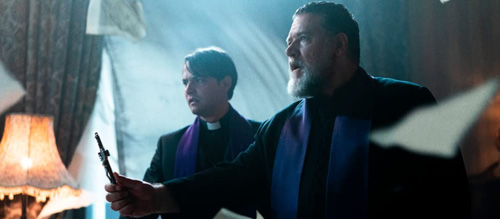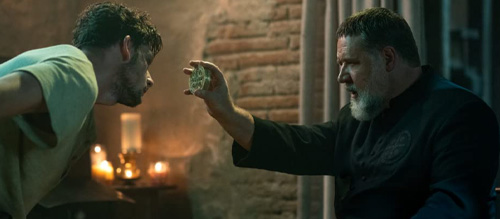The Pope’s Exorcist (2023) Review

The Pope’s Exorcist (2023)
Director: Julius Avery
Screenwriters: Michael Petroni, Evan Spiliotopoulos, R. Dean McCreary
Starring: Russell Crowe, Daniel Zovatto, Alex Essoe
There is a rich history of films that prey on good old-fashioned Catholic guilt. From The Exorcist to Rosemary’s Baby to First Reformed, one of the best ways to scare the public is through our fragmented relationship with God. Something about a child swivelling their neck at an impossible angle or screaming vulgarities at a priest has always delighted and terrified audiences. Unfortunately, The Pope’s Exorcist fails to tug at the moral panic-stricken heartstrings. Maybe it’s because it has been done so many times, or maybe we’ve finally worked through our deep-seated shame, but Catholic guilt just doesn’t hit like it used to.
All of the classic exorcism tropes exist in The Pope’s Exorcist. There is the high-ranking yet unorthodox priest, a family torn apart by the tragic death of the father, and even an abandoned abbey that the family is forced to live in. The story is fairly cookie-cutter. Chief Exorcist Gabriele Amorth (Russell Crowe) is an Italian priest who presides over demon extraction affairs from the early 80s until well into the 21st century. He challenges the authority of the church while advocating for the eradication of evil. Meanwhile, an American family moves to Spain to fix up an old abbey that was passed down by the deceased father. Almost immediately, the mute, grief-addled son Henry (Peter DeSouza-Feighoney) falls victim to the highest king of hell who wreaks predictable havoc on the family. Naturally, Father Amorth is called to the scene to vanquish this evil.
The opening scene is by far The Pope’s Exorcist’s most captivating. Amorth is called to the house of a young man who has been apparently seized by the devil. In this sequence, Crowe is able to showcase his over-the-top and sometimes even comedic portrayal of Father Amorth. The priest is sharp-tongued and quick-witted, able to taunt Satan with the cutting words of a high school bully. Upon arrival, Amorth is informed that the young man is speaking in English, a language he does not know. Without missing a beat, the priest asks if the family has a TV. When the answer is yes, Amorth is immediately suspicious. After “Satan” is unable to correctly identify Amorth, the priest brings a pig into the room and instructs the demon to possess it. After a moment, the priest whips out a gun, shoots the creature, and tells the man to go to sleep as he has been rid of his demons. Later it is revealed that Amorth didn’t perform an exorcism at all and instead used “theater” to cure the man of a bout of psychosis.
At this point in the film, it seemed like there could be an interesting foray into the fate of the Catholic church. There is a brief mention of modernization and a need to keep up with the times (including abandoning exorcism altogether). Given the saturation of the possession film category, this felt like a relevant, meta, and darkly funny approach to the subject matter. Instead, it became clear that Amorth’s belief in eradicating evil through a plain old exorcism was the winning way, and the film segued back into standard exorcism territory.

This is the crux of the problem with The Pope’s Exorcist. In 1973, when The Exorcist was first released, we lived in an entirely different society. Though some religious fears of course remain the same, the audience watching was completely in awe of the vulgarity and directness with which the film approached religious fear. Now, we’ve had 50 years and nearly three generations grappling with God, innocence, and possession. Attitudes have changed and our films should mirror that.
One of the best examples of a modern take on the supernatural is Ari Aster’s Hereditary. The film captures complicated family dynamics and unpacks the overwhelming nature of grief and guilt while also understanding that people are not the devout worshippers of organized religion that they once were. Aster presents a skeptical, “ordinary” family who is so devastated by trauma that their real-life feels just as hellish as the supernatural one. We are able to take the plunge with him into the depths of the underworld because the alternative is facing these very human subjects who are so tormented by the facts of their real life.
The Pope’s Exorcist, on the other hand, clings so hard to old-fashioned cliches that it becomes more of a buddy comedy or an action flick than a proper horror movie. It would be almost funny if the conflict between the demon and priest weren’t so dreadfully dull. At times, the film leans so hard into old tropes that it seems to make fun of itself without meaning to. Though Crowe delivers a standout performance that is somehow layered and unique, it is not enough to save this flat script and uninteresting religious dilemma.
Score: 10/24

